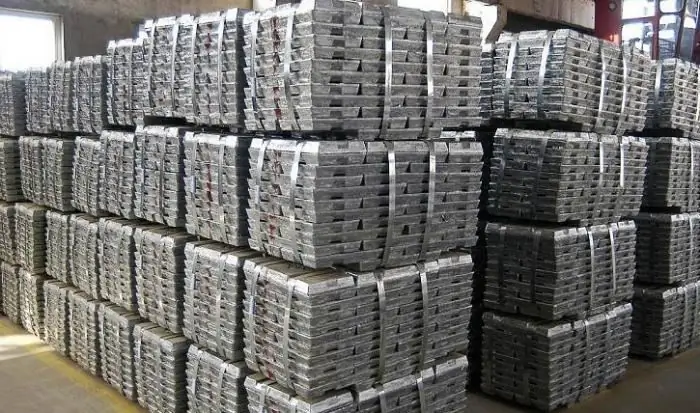2026 Author: Howard Calhoun | [email protected]. Last modified: 2025-01-24 13:10:37
Of all the 104 chemical elements known to mankind today, 82 are metals. They occupy a prominent place in the lives of people in the industrial, biological and environmental fields. Modern science divides metals into heavy, light and noble. In this article, we will look at the list of heavy metals and their features.
Determination of heavy metals
Initially, it was customary to call heavy metals those representatives that have an atomic mass above 50. However, the use of the named term today occurs more often not from a chemical point of view, but depending on their impact on environmental pollution. Thus, the list of heavy metals includes those metals and metalloids (semimetals) that pollute the elements of the human biosphere (soil, water). Let's take a look at them.
How many items does the list of heavy metals include?
Today, there is no consensus on the number of elements in the named list, since there are no general criteria relating metals toheavy. However, a list of heavy metals can be formed depending on the various properties of the metals and their attributes. These include:
- Atomic weight. Based on this criterion, more than 40 elements with an atomic mass greater than 50 amu (g/mol) belong to the named ones.
- Density. Based on this criterion, those metals are considered heavy, in which the density is equal to or exceeds the density of iron.
- Biological toxicity combines heavy metals that adversely affect the life of humans and living organisms. There are about 20 items on their list.
Effect on the human body
Most of these substances have a negative impact on all living organisms. Due to the significant atomic mass, they are poorly transported and accumulate in human tissues, causing various diseases. So, for the human body, cadmium, mercury and lead are recognized as the most dangerous and the heaviest metals.
The list of toxic elements is grouped according to the degree of danger according to the so-called Mertz rules, according to which the most toxic metals have the smallest exposure range:
- Cadmium, mercury, thallium, lead, arsenic (a group of the most dangerous metal poisons, exceeding the permissible limits of which can lead to serious psycho-physiological disorders and even death).
- Cob alt, chromium, molybdenum, nickel, antimony, scandium, zinc.
- Barium, manganese, strontium, vanadium, tungsten
This however does not mean that none of the elements grouped above areMertz's rules, should not be present in the human body. On the contrary, the list of heavy metals includes these and more than 20 elements, a small concentration of which is not only not dangerous for human life, but is also necessary in metabolic processes, especially iron, copper, cob alt, molybdenum and even zinc.
Environmental pollution with heavy metals

The elements of the biosphere that are polluted by heavy metals are soil and water. Most often, the culprits for this are metallurgical enterprises that process light and heavy non-ferrous metals. The list of polluting agents is also added to by waste incinerators, car exhaust, boiler plants, chemical manufacturing, printing companies and even power plants.
The most common toxins are: lead (automobile production), mercury (example of distribution: thermometers and fluorescent lighting devices broken in everyday life), cadmium (formed as a result of burning garbage). In addition, most factories in production use one or another element that can be described as heavy. The metal of the group, the list of which was given above, in the form of waste most often enters water bodies and then reaches humans along the trophic chain.
In addition to technogenic factors of nature pollution with heavy metals, there are also natural factors - these are volcanic eruptions, in the lava of which an increased content of cadmium was found.

Features of the distribution of the most toxic metals in nature
Mercury in nature is most of all localized in the water and air environment. Mercury enters the waters of the world's oceans from industrial drains, and there are also mercury vapors formed as a result of coal combustion. Toxic compounds accumulate in living organisms, especially in seafood.
Lead has a wide area of distribution. It accumulates in mountains, and in soil, and in water, and in living organisms, and even in the air, in the form of exhaust gases from cars. Of course, lead enters the environment as a result of anthropological action in the form of industrial waste and non-recycled waste (batteries and batteries).

And the source of environmental pollution with cadmium is the wastewater of industrial enterprises, as well as natural factors: weathering of copper ores, soil leaching, as well as the results of volcanic activity.
Heavy Metal Applications
Despite toxicity, modern industry creates a huge variety of useful products by processing heavy non-ferrous metals, the list of which includes alloys of copper, zinc, lead, tin, nickel, titanium, zirconium, molybdenum, etc.
Copper is a highly ductile material that is used to make a variety of wires, pipes, kitchen utensils, jewelry, roofing and more. In addition, it is widely used in mechanical engineering and shipbuilding.

Zinc has high anti-corrosion properties, so the use of zinc alloys for coating metal products (so-called galvanization) is common. Areas of application for zinc products: construction, mechanical engineering, printing (printing plates), rocket science, chemical industry (varnishes and paints) and even medicine (antiseptics, etc.).

Lead melts easily, therefore it is used as a raw material in many industries: paint and varnish, chemical, automotive (included in batteries), electronics, medical (production of protective aprons for patients during X-ray examinations).
Recommended:
Ferrous metals: deposits, storage. Metallurgy of ferrous metals

Metals are materials that never lose their relevance. They are widely used in household and industry
Platinum group metals: overview, list, properties and applications

Platinum group metals are six noble precious chemical elements that are located side by side in the periodic table. All of them are transition metals of 8–10 groups of 5–6 periods
Precious metals quotes at Sberbank. Precious metals (Sberbank): prices

One of the most profitable investments is the purchase of precious metals such as gold, silver, platinum, palladium. This has been the case for many years and remains so today. In times of economic crisis, this option is even more relevant
Alloy metals: description, list and application features

Development is identified with improvement. Improving industrial and domestic capabilities is carried out through the use of materials with progressive characteristics. These are, in particular, alloyed metals. Their diversity is determined by the possibility of correcting the quantitative and qualitative composition of alloying elements
Examination of metals and alloys: features, description and requirements

Examination of metals: general description, stages of its implementation. Typical tasks that a forensic examination solves. Methods for the study of metals and alloys. Rules for drawing up conclusions and their examples. Requirements for expert laboratories

